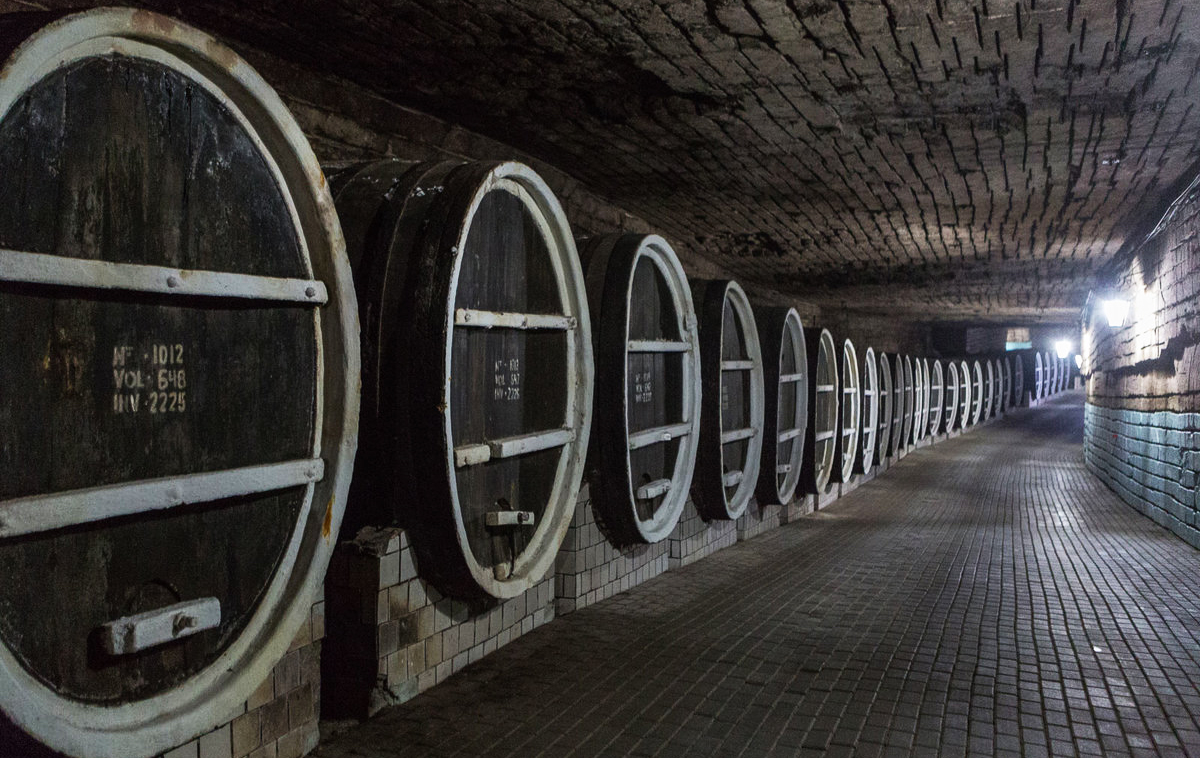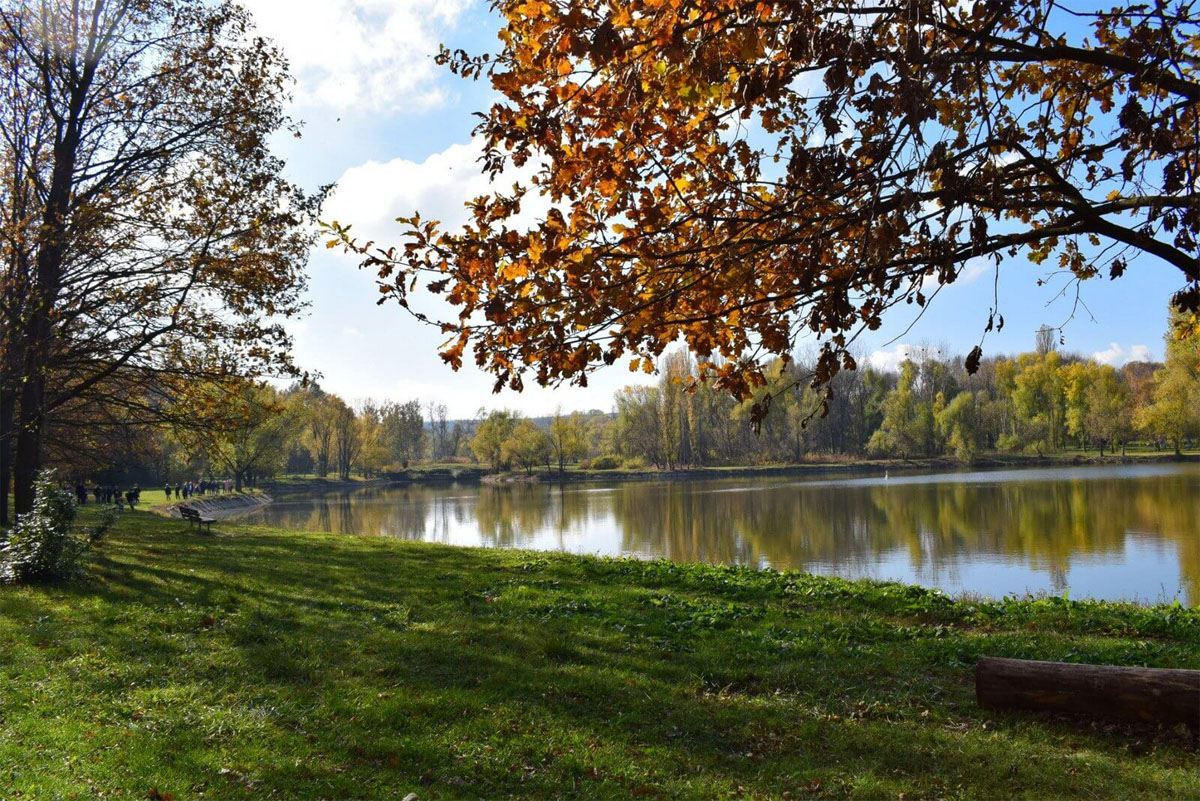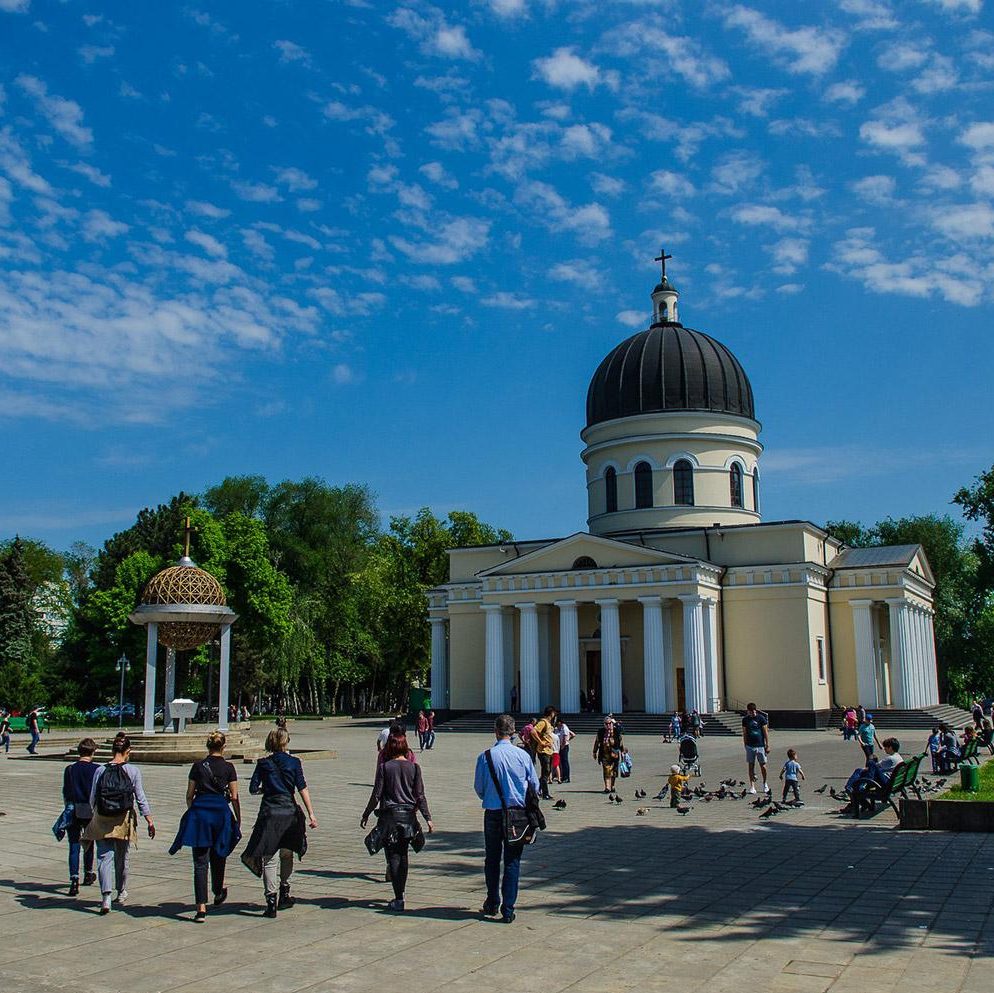Turn one corner in Zemstvo House in Moldova’s capital city of Chișinău and you’ll see a standalone television in a dark room, playing a series of videos on loop. In another direction, a hall of blacklit mandalas give way to the courtyard of the self-proclaimed Queer Café, where creeping ivy contrasts with the chilly air. Zemstvo is covered in photos, posters, and manifestos, sometimes pasted on the wall with painter’s tape or edited in the margins with scribbles of black pen.
In this decaying building rented out by the National Museum of Ethnography and Natural History to independent artists, room after room houses studios for hardscrabble, ragtag creators who build their own bicycles and pick up new outfits in the clothing donation rack.
In one, books on Marx, Walter Benjamin, art theory, and Lenin share space with graphic novels and Soviet-era kitsch. Electronic music blares while artist Maxim Polyakov waves a stick of incense. The scent evokes the Eastern Orthodoxy of Moldova’s sprawling, centuries-old monasteries nestled in the country’s valleys and groves.
Polyakov tells me to climb up the ladder tilted against wide-open windows into what was once the museum’s courtyard. An anarchist with a long beard and a baseball cap is making soup. Old tanks and piles of wood and scrap heaps are strewn about the space. It has a forgottenness to it—a quality of being ripe for the taking. Polyakov’s artist collective hosts parties out here, a space they call the Stalker Garden—a reference to Roadside Picnic, the Soviet science fiction novel by Arkady and Boris Strugatsky, perhaps better known through its 1979 film adaptation Stalker, directed by Andrei Tarkovsky. For many critics, the film reflected the Soviet Union’s nuclear anxieties—what it means to be able to manipulate matter past the limits of our control or understanding. In the film, salvagers and dreamers travel through a place where regular laws of time do not apply, a space misunderstood by the outside world.
Moldova is rarely spotlighted by western media, with occasional exceptions for corrupt oligarchs, prison tuberculosis, or black-hat hackers. It lays claim to being the least-visited country in Europe, with only 391,500 travellers making their way there in 2023. That means its ancient ruins, luxury wine spas, and riverside parties go largely unnoticed. Gems like Mileștii Mici—the site of the largest underground wine cellar in the world, where hundreds of limestone tunnels house galleries and a cinema—are overlooked. And in the capital, Chișinău, the city’s vast parks and botanical gardens remain quiet enough to easily score a park bench, where you can sip honey tea with lemon or overhear a lively game of chess. Meanwhile, in sun-drenched cafés, 20-somethings read Orwell in Cyrillic or ask you which flavour you want in your raf—a sweet latte-like beverage made with cream, forged in the post-Soviet Russian coffee scene of the late 1990s.

An underground cellar. Photo courtesy of Milestii Mici.
The relative obscurity of Moldova also means that when you’re out on streetcars and in markets, people who hear you’re a visitor welcome you with open arms. In this part of the world, toothy smiles are often eschewed for conspiratorial nods, as if you’re being brought in on a secret. And it does feel like a secret to be here. From the Soviet-era architectural gems to the acres of fruit orchards and vineyards, the country is a bottle of adventure.
A week later, I’m a few drinks in outside Plincuvin, a luxe wine shop where expats and locals regularly spill out of the few tables inside, carrying glasses and bottles onto the street—a patio experience without a patio. “You should write about how we want to be part of Romania,” a new friend tells me. It’s not the first time I’ve heard this here—my cab driver said something similar the previous night. It’s a reflection of Moldova’s very odd history. After the country bounced back and forth between Romanian and Russian influences over the years, the Soviets took control of what was then Bessarabia in the Second World War, made most of it into the Moldavian Soviet Socialist Republic, and enforced a new national identity.
Related stories
- Walking Turkey’s Lycian Way Conjures Myths, Monsters, and Magic
- Descending Into a Dark Past in the Crystal Caves of Belize
- In Golden, B.C., an Alpine-Inspired Village Preserves Mountain-Culture History
That history left Moldova profoundly unique in the multiplicity of its influences. Home to an ethnic-Romanian majority alongside Russians, Ukrainians, and other minority groups, today it is a melting pot of ideas and identities. On the outskirts of the capital near autobody shops and highways, I step in to Gök-Oguz, an outpost for the Balkan culture that makes up the country’s Gagauz Yeri autonomous region farther south. Owner Timbal Ruslan—who is a mix of Ukrainian and Gagauz origins and fluency in the Romanian language himself—cracks me a fresh walnut. He sends a warm pastry filled with herbaceous sheep cheese to my table as the servers pass hearty mutton dishes to my neighbours. This food, Ruslan says, tells the story of a people who migrated from Turkey and Bulgaria to the land that is Moldova today: it’s a spicy “cocktail of Balkanic traditions.”
Stories like these are sometimes overshadowed by the drama of nearby Transnistria, a contested breakaway region that declared independence from Moldova in the early 1990s during the final days of the Soviet Union. When Moldovan leaders proposed rejoining Romania, Transnistrians started a war. Backed by Russia, the noncountry’s borders are still policed by Russian peacekeepers today—and after a recent energy crisis when Russia stopped delivering natural gas to the region, it has become a focus point for tensions between East and West.
That contested zone is a place Polyakov explores in his art. It’s also his homeland. Back in the Stalker Garden, he introduces me to his friends from the region and pours us shots of Transnistria’s famous KVINT brandy. “For the culture,” I toast.

The Chișinău Botanical Garden of the Academy of Sciences of Moldova. Photo courtesy of Visit Chișinău.
When I arrived, I witnessed a particularly liminal moment for Moldova. An EU referendum was still being counted due to razor-thin margins, and a first-round presidential race saw the pro-European candidate fail to win enough votes for the presidency, causing a runoff occurring less than two weeks after my arrival. For the next few days, the country felt suspended in time, waiting for a decisive announcement about Moldova’s direction. In the end, darling of the West Maia Sandu won by a slim margin thanks to an impressive and almost unanimous showing from diaspora voters in embassies across the globe. But after reporters left and filed headlines about a decisive European step for Moldova, the country remains divided over its future and facing a much more contentious election for parliament in only a few months.
Polyakov’s friend Vladislav, who works as a web designer, tells me he travels into Chişinău from Transnistria every weekend to go to parties and see art with friends. He voted, and not for the European option. He wants to see Moldova as “a kind of bridge”—a translation space, where east and west learn from and understand each other.
Transnistria is arguably the best-known area of Moldova (or not-Moldova, depending on your perspective), infamous as a time capsule doggedly preserving the memory of the Soviet Union. Monuments honour that long-defunct project’s achievements in space travel, aviation, and battle. And a granite Lenin, cape suspended in the wind behind him, still guards Transnistria’s parliament building in Tiraspol. But the unrecognized state is not the only place in Moldova where history intrudes into the present. “It exists in our context. We don’t bring it from the past—it exists here in this room,” Polyakov says. From Pushkin Street to the sprawling tram network to the wide, Soviet-era boulevards, Chişinău residents are still constantly moving through socialist infrastructure—the physical manifestation of prior ideologies. “And this structure makes context, makes material conditions. This shape still exists,” Polyakov explains. “Most people here were constructed by things which were born in this Soviet time. If you just cancel these things, we [lose our way] to a place where we were born. Even opposition to Soviet times—you should keep this as opposition to something that should be maybe rediscovered.”
In the dilapidated halls of the old museum property, Polyakov was recently working with other artists on a collective poster project revisiting Soviet perceptions of space and the cosmos—and how space reminded people they were part of something bigger. “We start to see history not as something linear which goes from past to future—but as the cosmos, which has everything in the same moment,” he says. “Instead of a linear way of historical perception … that it was, and we never can go back … it’s all present.”
Read more travel stories.









